Today, lead generation is an integral part of almost every business.
And acquiring leads is one of the main objectives. Hence, companies dedicate a lot of resources to lead generation.
But the hard fact is that-
“Your audience no longer wants you to buy their attention—they simply want you to earn it.”
So it means that you have to fill those leads in your funnel who are interested in your product and further qualify for sales.
Without qualified leads, your sales team’s productivity suffers, and it is very challenging to cultivate and convert new prospects.
Because capturing the attention of your target audience is becoming increasingly difficult day by day, therefore, you must have clear and effective lead-generation strategies in place to succeed.
So in this post, I am going to share a deep overview of the “approach to killer lead generation” to overcome these challenges.
To make sure that we are on the same page, let’s begin by understanding the basic difference between “what are leads?” and “what are not leads?”
Table of Contents
What Are Leads?
Leads are the contact details of potential customers who might become paying customers of your business sooner or later.
They always have relevance to your business and products. That means the contact details of random people are not leads.
Contact details are usually the names, email addresses, and phone numbers of prospects.
Leads can be further defined into three types:
- Cold Leads (not aware of you and your product)
- Warm Leads (Aware of you and your product)
- Hot Leads (Ready to Buy)
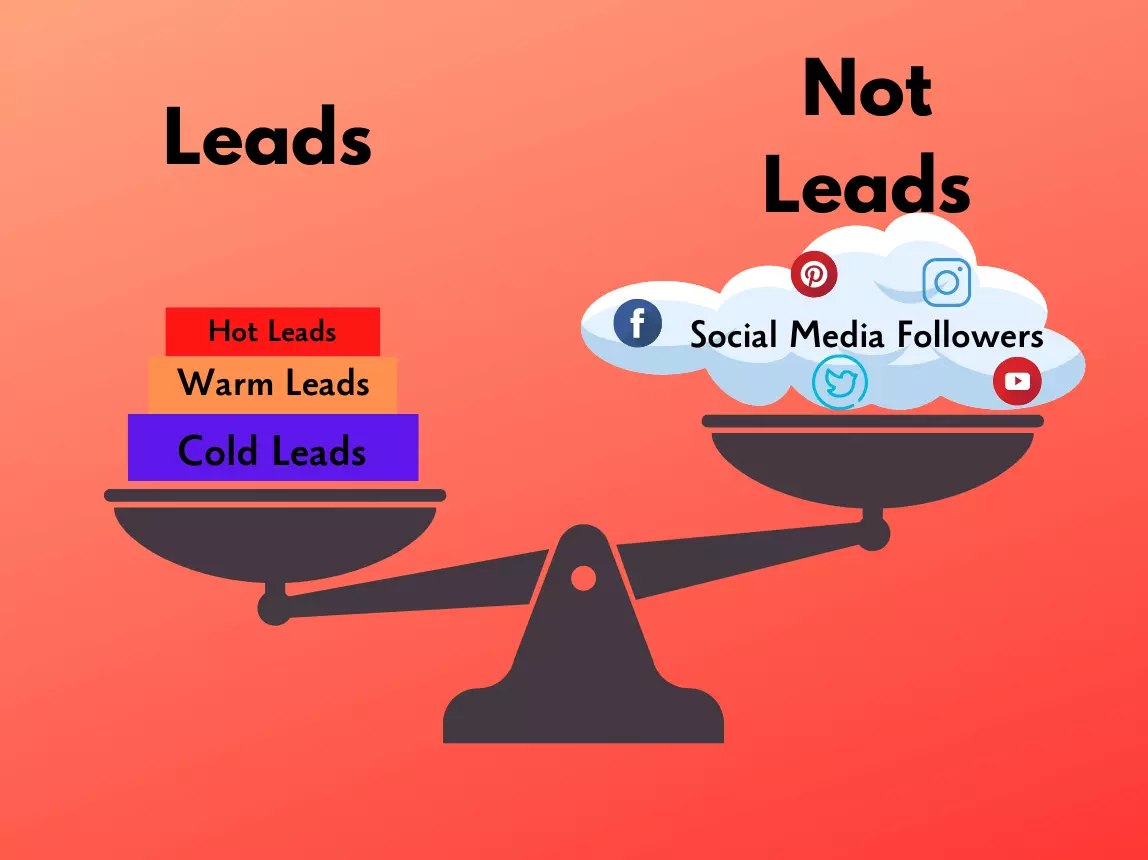
What are not leads?
Social media followers are not your leads. If you have social media followers, then try to convert them into a database of names and email addresses by using lead magnets and advertising.
You might ask them to follow you on social media by communicating with them through emails, webinars, private groups, and communities.
Spend your money on paid advertising rather than acquiring more followers on social media.
It is the best social media strategy.
Now let’s look at the definition of lead generation…
Lead Generation Marketing: Definition
Lead generation is the initial stage of a customer’s journey through the marketing funnel. It involves capturing potential customers and developing them into warm leads through engagement in an effort to qualify them as paying customers.
Here potential customers refer to “cold leads,” and paying customers to refer to “hot leads.”
In simple words, lead generation is the process of attracting people in order to increase their interest in products and services and eventually convert them into paying customers.
The Lead Generation process mainly includes 5 steps:
- Capturing leads using lead magnets.
- Engagement with leads.
- Nurturing the leads.
- Lead scoring.
- Qualifying leads for sales.

To do this, you must first provide appealing content that you can use as a lead magnet to attract cold leads.
You must then engage these leads with a drip marketing campaign to turn them into warm leads and eventually nurture them into hot leads that are qualified for sales.
Lead Generation Objectives
- Gathering customer data for personalized communication.
- Building a tribe or a community.
- Building trust.
- Create more marketing opportunities.
- R&D for product development
- Personal Branding.
- Better Conversion rates.
Before we get into lead generation strategies, let’s go over some lead generation ethics because having people’s contact information gives you a lot of power.
And it is important to understand one’s responsibility while having so much power.
Ethics of Lead Generation
Once you have a lot of leads in your database, you have a lot of power in your hands.
By implementing methods of lead generation, you are going to have thousands of leads in a very short time.
“With great power comes great responsibility.”
So it is very important that you respect the privacy of your leads and respect their contact details.
You should never get email addresses from an unethical source and start sending bulk emails without consent.
Consent is the most important thing to take care of because a lot of people make this mistake.
For B2B leads, send only prospecting emails via your own email account. Do not use email marketing services and start blasting out emails directly.
B2C leads always generate leads via advertising instead of collecting them from unethical sources. You should never buy or download a database of emails.
In B2C emails where you use email marketing tools, always include an “unsubscribe button” in every email you send.
Allow people to unsubscribe from your mailing list. And never send emails to leads once they’ve opted out of your emails.
Always keep your email-sending reputation high to ensure high email deliverability rates.
Your domain name’s email address is extremely important. It is sacred, so always take care of your reputation.
Best lead generation marketing strategies
Lead generation strategies differ according to target markets and industries.
And we need to pay close attention to each market or industry to run more impactful and measurable marketing campaigns.
This means lead generation strategies need to be refurbished across the industry to better meet the needs of target markets.
B2B And B2C Lead Generation
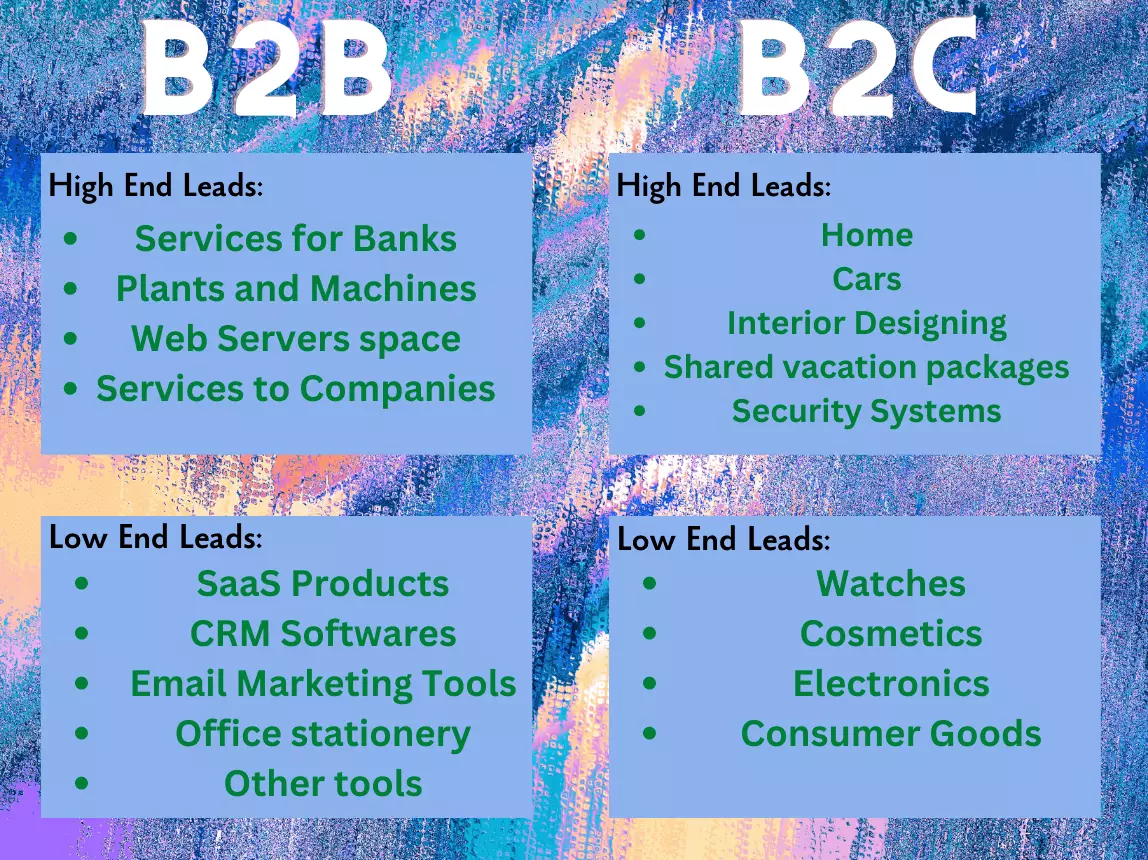
If a product is a high-end B2C product, you need marketing to generate leads and sales to close the leads.
With B2C products, the prospects are not obvious, so marketing has to generate leads for you.
In the case of B2B product lead generation, it is difficult and more direct. You need to do research and prospecting to generate leads.
With low-end B2B products, again, you need marketing to generate leads and automation to nurture the leads and close the sales.
Furthermore, in low-end B2C products, you cannot afford to have a sales team follow up with all leads
B2B Lead Generation Methods
B2B lead generation is mainly concerned with outreach and prospecting.
In the initial stages, you can generate leads manually by convincing them to be your clients.
Because there are fewer leads, conversions are lower and ticket volumes are higher. Therefore, it needs personal interaction to go ahead and convert them into a customer.
When your B2B business grows over time, you will apply the principles of B2C lead generation to generate B2B leads at scale.
And just like that, you can also apply B2B lead generation techniques to B2C by reaching out to the people directly until the product market fit is established during the initial stages of the business.
You can invest money in marketing only after getting your numbers to some level of predictability because product-market fit may not be established in the early stages of B2C.
So, it’s better to reach out to customers and get some predictability in the market to know how the market perceives your product.
If your product or service is valuable enough, you can manually engage B2B leads and close the sale without relying heavily on lead nurturing and marketing automation.
Steps to B2B lead generation:
- The 1st step is to identify prospects based on your research and educated guesses.
- The 2nd step is to find out their contact details so they can be reached out directly to request a meeting or call.
- Contact pages on blogs and websites are good ways to reach out to people, Twitter and Linkedin are other platforms to contact people although the success rate can be less. You need to play a volume game here.
- You can use the Hunter.io extension for the web and getprospect.io for LinkedIn to collect email ids.
- Once you get their email addresses you can reach out to them via email.
- You can semiautomate the process by using tools like G-mass And Yamm.
B2C Lead Generation
Let’s discuss B2C lead generation now and determine how it differs from B2B lead generation.
Low-cost consumer products and commodities don’t require lead generation because, for these goods, it is not possible for firms to afford a sales team.
Most of the time, people don’t need anyone to contact to buy a product. (Ex. purchase from E-commerce stores and shopping malls.)
For high-end B2B products, the leads can be identified and engaged manually.
When B2B & B2C products fall somewhere in the middle where the cost is not high enough to do only manual engagement and the cost is not low enough to just run ads the concept of funnels comes in.
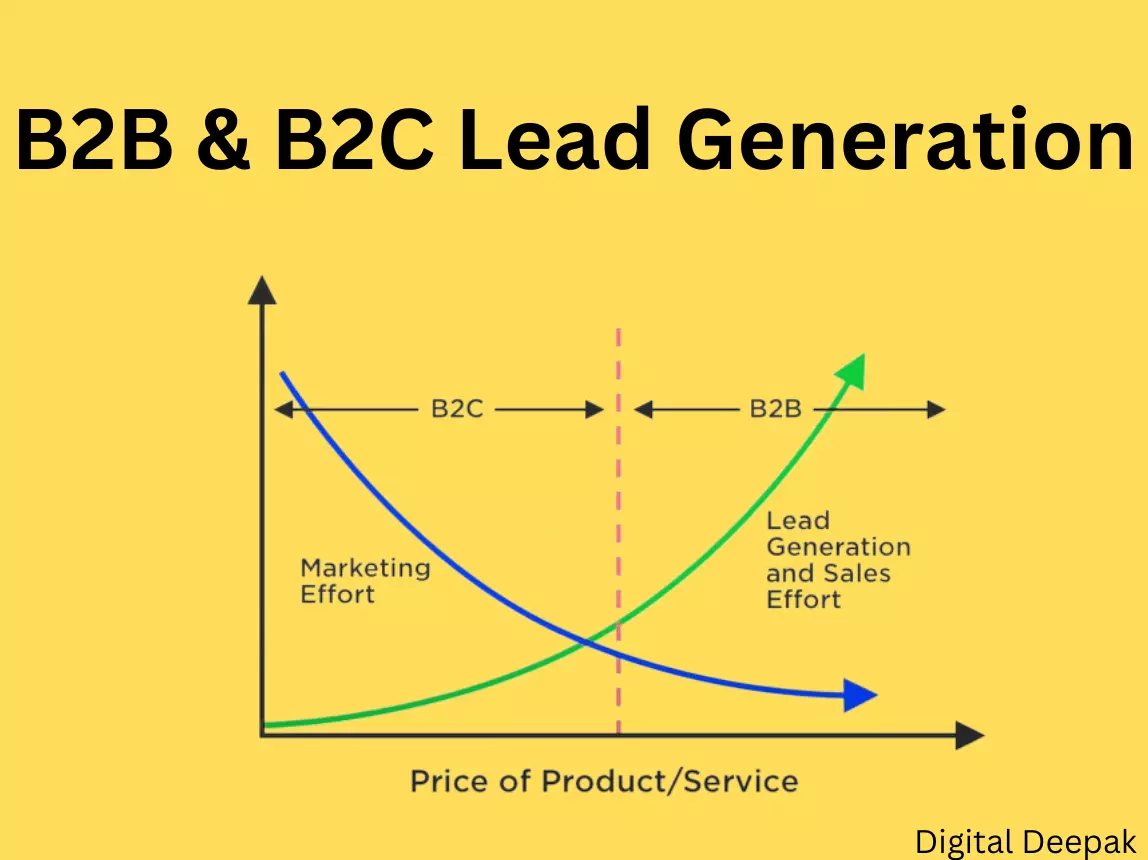
Advertising will bring leads, marketing automation will convert those leads, and then, based on lead scores, high-quality leads can be engaged manually to buy (via webinars, sales calls, or custom sales pages).
Once the funnel is set up properly, leads can be scaled via automation to large numbers.
Your funnel always gives you profit because once a prospect comes into your funnel and is well nurtured by automation, after some time it converts into a paid customer.
The CATT Marketing Funnel Framework can be used to generate B2C leads.
CATT Marketing Funnel Framework
In this framework, you create lead magnets in the form of content first, then get attention by driving traffic to them via landing pages and converting them into leads.
After getting their attention, you generate trust with your leads and make them engage in a transaction with you.
Let’s look at this framework more deliberately:
Content (Lead magnets)
To attract people to you, you must first create content.
This is evident in all traditional media. TV, radio, newspapers, and magazines all have ads in the form of visual, audio, and written content.
Therefore, content is the starting point of all attention; nobody is going to pay attention to ads without the content.
So it is the root of all attention, and that’s why you have to create content first.
Your content should be an upgrade that is a lead magnet—(premium content)—so that people can opt-in and give their contact details in return for a lead magnet.
Having free content like a blog post helps you gain traction on search engines and social media.
A lead magnet is usually delivered via a popup on a website. People will enter their name, email address, and maybe their phone number in the return link of the lead magnet.
When running paid advertising and viral campaigns, the lead magnet is usually delivered via a landing page.
A landing page has only one call-to-action, i.e., get them to enter their contact details.
Lead magnet ideas:
The content given as a lead magnet can take different shapes and forms
The most commonly used ones are e-books, white papers, mini-courses, and webinars.
Memberships in VIP groups and clubs can also work as lead magnets.
Application forms, tools, calculators, and free reports can attract high-quality leads with much more information than just names and emails.
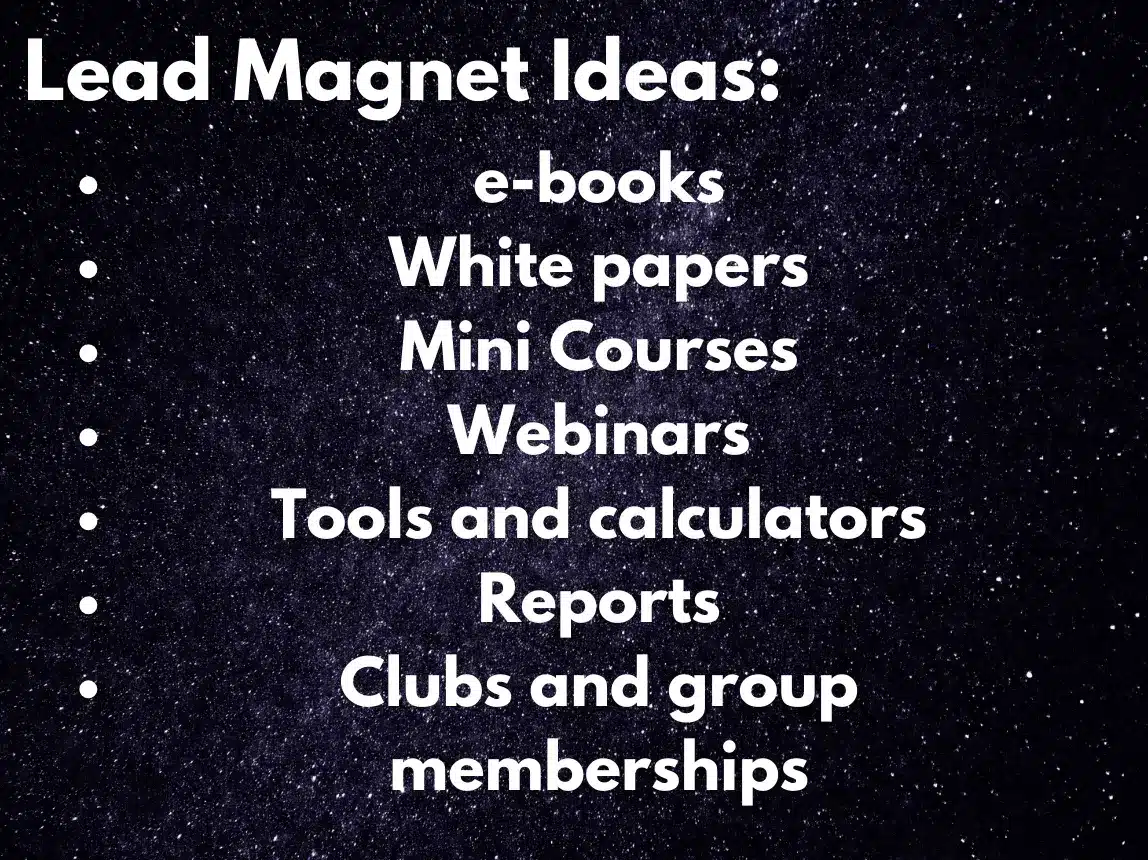
The more information you have, the more personalized your campaigns become.
Hubspot generates more than 2.5 million leads via grader.com, a tool for checking the performance of a website in exchange for the contact details of the user, which becomes their lead.
Leads can also be generated by mobile or desktop apps. Most apps require the user to register using an email ID before you can use them.
(Click Here to get access mind map of “Types of Content”)
Landing Pages and Popups
A good-converting landing page is an asset that can be used for a long time.
Good designs, visual representations of lead magnets, testimonials from existing customers, and a clear message all help a lot in building a highly converting landing page.
Your landing page titles can be customized according to different traffic sources.
A better match between the title of the landing page and the ad copy increases the landing page’s conversion rate.
The more lead magnets you have, the more leads you can generate from different sources.
You should also pay attention to the details you get on the landing page.
Fewer the details are required on landing pages, the higher the conversion rates will be.
Usually, most landing pages just ask for names and emails.
Adding a phone field can reduce the conversions of pages.
So, always try to collect as little information as possible on landing pages; Additional information about prospects can be captured later in your funnel.
Now let’s shift to the next part of the CATT funnel…
Attention: Driving traffic to your Content
Once your lead magnet is ready, it will not become popular by itself.
It would be best if you drive some attention to your lead magnets using organic and paid methods.
The organic method includes driving traffic through SEO and social media channels to your blog, where you publish the content.
And paid methods include driving traffic via paid advertising on Facebook, LinkedIn, Twitter, Quora, Pinterest, and Google Ads.
Publishing books, apps, guest posts, and press releases can also get a lot of traffic for you.
Always drive traffic to your blog; some specific landing pages can also be hosted on your blog.
Your blog home page should also be used as a landing page for a generic lead magnet.
You can also run contests, giveaways, and viral loops, which are highly effective ways of generating leads. And people always tend to promote these kinds of lead magnets.
After driving traffic to your content, you have to build trust with your leads.
Let’s have a quick overview of the trust part of the funnel.
Building Trust: Nurturing the leads
When you generate leads, they are cold in nature because they don’t know you, your brand, or your product.
You have to convert these cold leads into warm leads before they are ready to buy from you.
The middle of the content can help with lead nurturing and developing trust with your leads. (In this mind map, you can get access to the middle of the content.)
A drip marketing sequence with follow-up messages on a consistent basis is the best way to engage your leads and form trust.
Today, trust is a very scarce resource, and it is developed over a series of conversations and getting to know someone for a long time.
A drip marketing sequence works as the flywheel of your marketing, which stores communication with your leads.
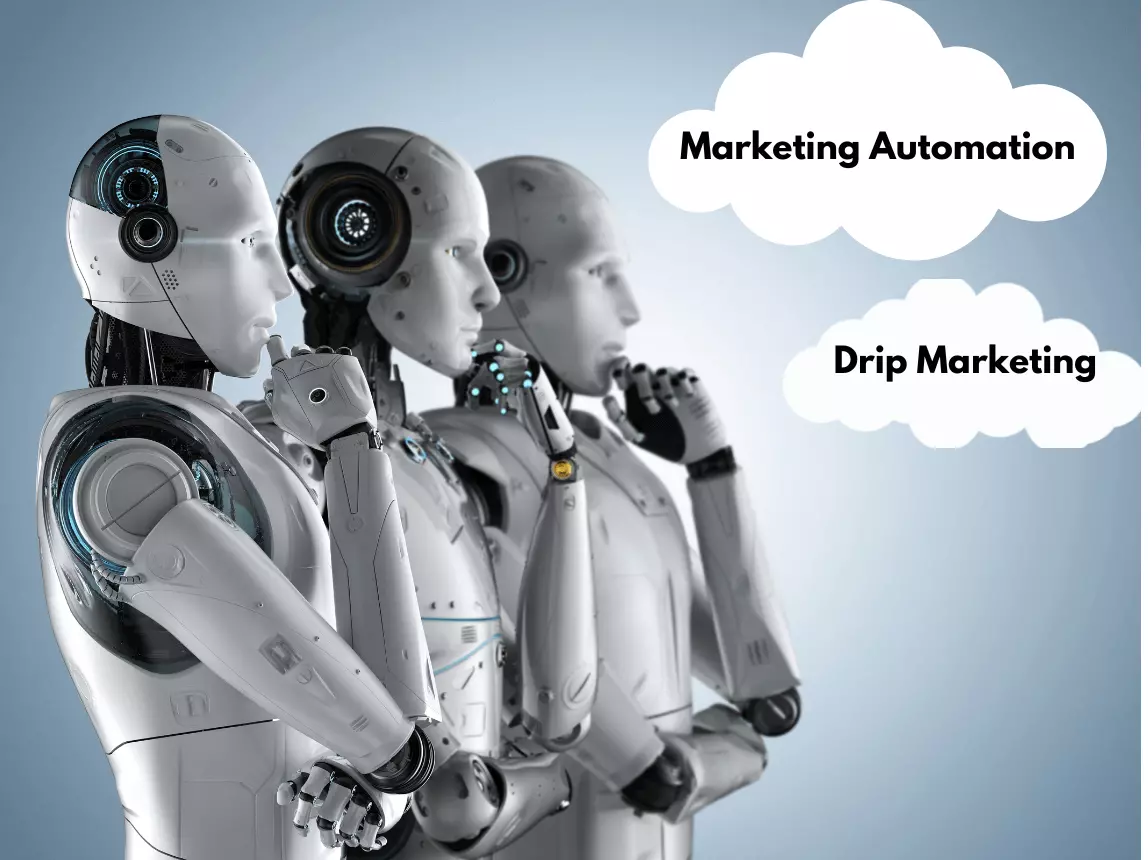
You have to automate all the engagement with your leads by following drip marketing sequences of your communication content delivered via emails on a consistent basis.
In this way, these customized engagements help you build trust and affinity over time.
After building trust with your leads, the next thing is to qualify them for doing a transaction with you and close the sale.
High-performance sales
Sales are the most important thing because without sales you cannot make profits, and without profits, you cannot reinvest the money into paid ads, landing pages, or anything else.
So transactions are the last part of the Catt funnel—they enable the sales in your business.
A good sales pitch with a good conversion is not just about your sales pitch.
Lead quality and lead warmth play a major role in your sales.
Sales can be made through meetings, sales calls, webinars, or sales pages with videos.
High-performance sales involve human psychology, emotional triggers, and a lot of advanced meta-tactics.
(I can discuss these tactics in another blog post or maybe in a video because I have almost written 2400 words until now and sales is a vast concept; so comment below if you want me to write about it or record a video about it.)
So at last Just remember that sales cannot happen without lead nurturing; Lead nurturing cannot happen without leads.
Leads cannot be generated without lead magnets (content) and traffic is driven to the content.
Conclusion
I just want to conclude that if you want to do killer lead generation you can apply all these methods in generating leads.
And for converting leads into sales you have to nurture them by providing value over a period of time.
Leads are the lifeline of a business and no business can say no to new customers. It is hard but you have to become better at it and become a pro at it.
Comment below if you have any insight over it; I will reply back that’s my promise to you:)
Cheers
Manthan Sharma
P.S.

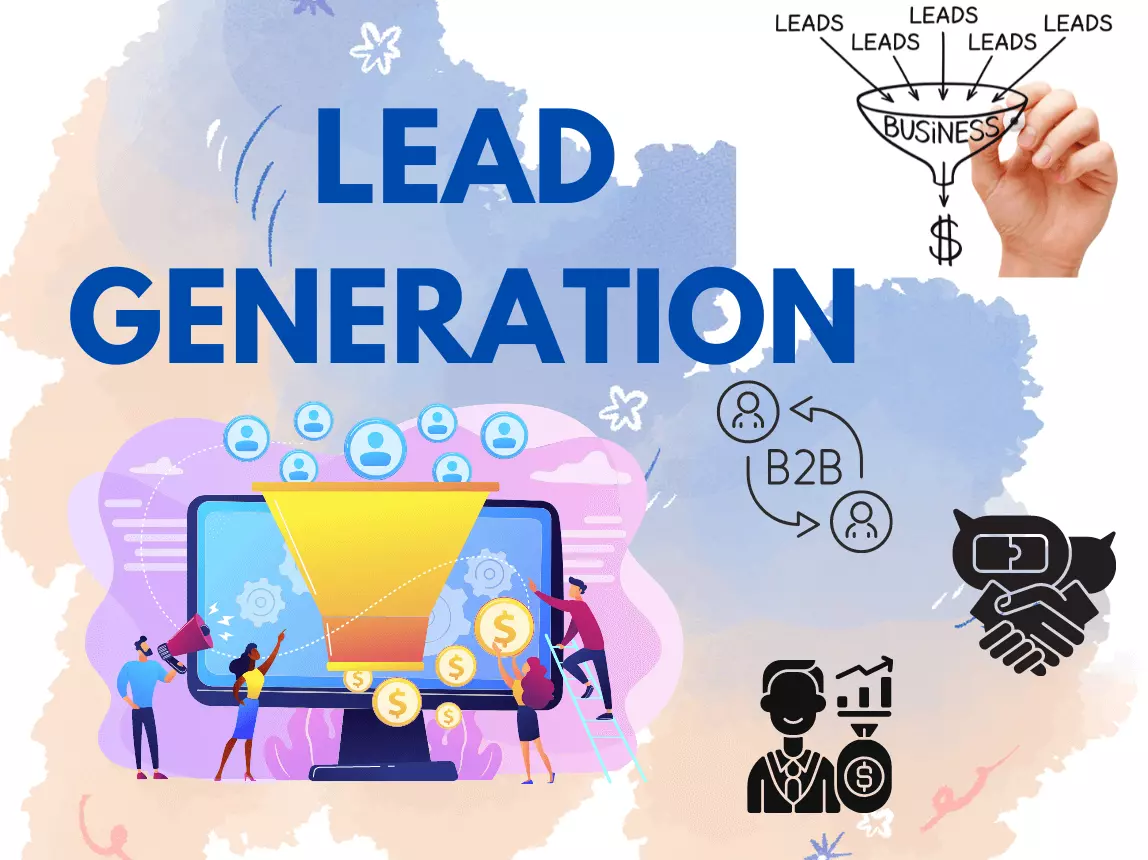
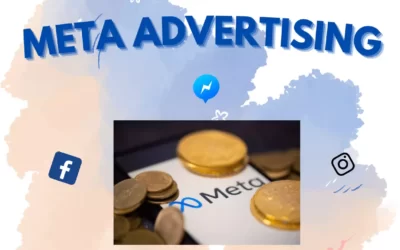
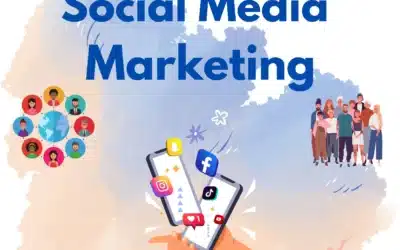


0 Comments